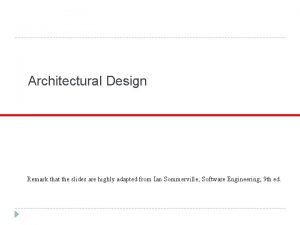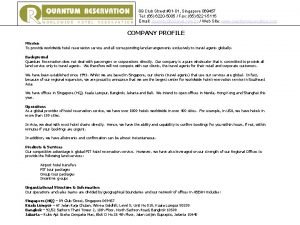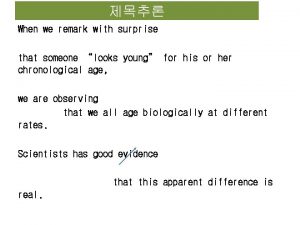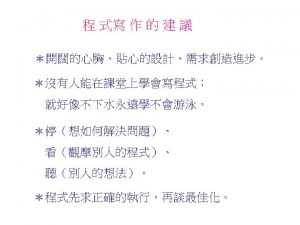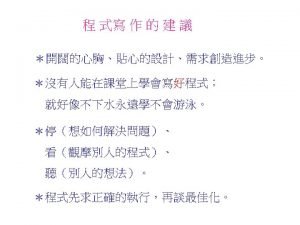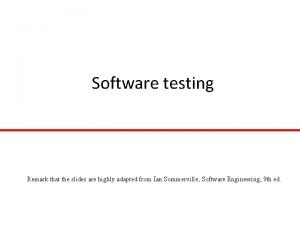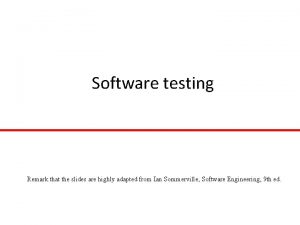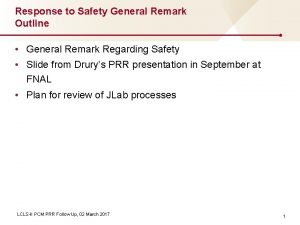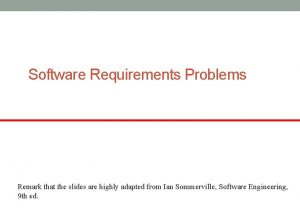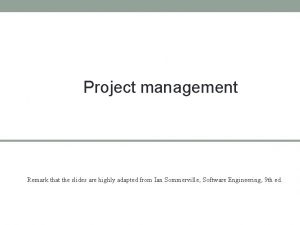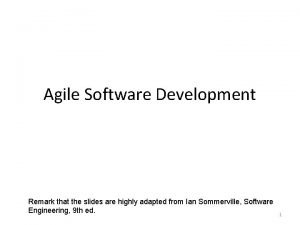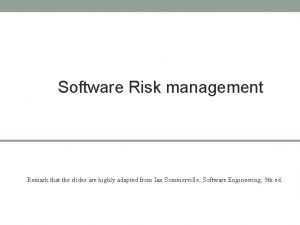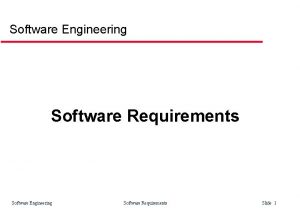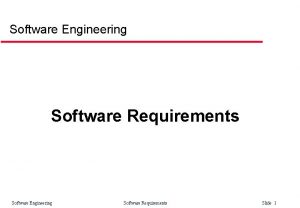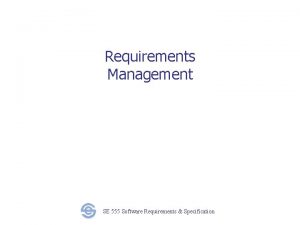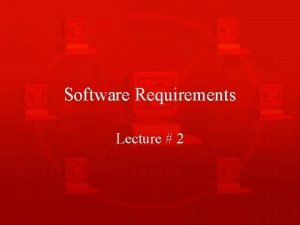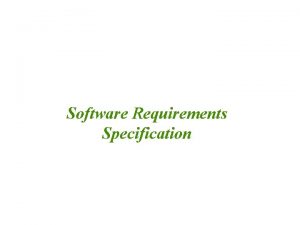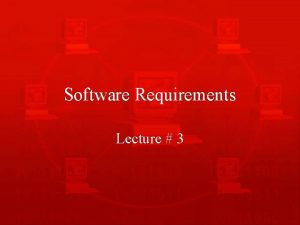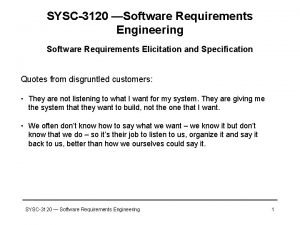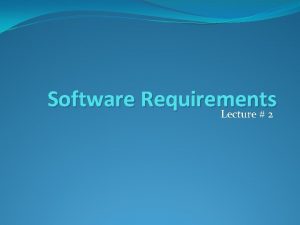Software Requirements Remark that the slides are highly

























- Slides: 25

Software Requirements Remark that the slides are highly adapted from Ian Sommerville, Software Engineering, 9 th ed.

Requirements engineering • The process of establishing the services that the customer requires from a system and the constraints under which it operates and is developed. • The requirements themselves are the descriptions of the system services and constraints that are generated during the requirements engineering process.

What is a requirement? • It may range from a high-level abstract statement of a service or of a system constraint to a detailed mathematical functional specification. • This is inevitable as requirements may serve a dual function • May be the basis for a bid for a contract - therefore must be open to interpretation; • May be the basis for the contract itself - therefore must be defined in detail; • Both these statements may be called requirements.

Types of requirement • User requirements • Statements in natural language plus diagrams of the services the system provides and its operational constraints. Written for customers. • System requirements • A structured document setting out detailed descriptions of the system’s functions, services and operational constraints. Defines what should be implemented so may be part of a contract between client and contractor.

Definitions and specifications

Requirements readers

Functional and non-functional requirements • Functional requirements • Statements of services the system should provide, how the system should react to particular inputs and how the system should behave in particular situations. • Non-functional requirements • constraints on the services or functions offered by the system such as timing constraints, constraints on the development process, standards, etc. • Domain requirements • Requirements that come from the application domain of the system and that reflect characteristics of that domain.

Functional requirements • Describe functionality or system services. • Depend on the type of software, expected users and the type of system where the software is used. • Functional user requirements may be high-level statements of what the system should do but functional system requirements should describe the system services in detail.

The LIBSYS system • A library system that provides a single interface to a number of databases of articles in different libraries. • Users can search for, download and print these articles for personal study.

Examples of functional requirements • The user shall be able to search either all of the initial set of databases or select a subset from it. • The system shall provide appropriate viewers for the user to read documents in the document store. • Every order shall be allocated a unique identifier (ORDER_ID) which the user shall be able to copy to the account’s permanent storage area.

Requirements imprecision • Problems arise when requirements are not precisely stated. • Ambiguous requirements may be interpreted in different ways by developers and users. • Consider the term ‘appropriate viewers’ • User intention - special purpose viewer for each different document type; • Developer interpretation - Provide a text viewer that shows the contents of the document.

Requirements completeness and consistency • In principle, requirements should be both complete and consistent. • Complete • They should include descriptions of all facilities required. • Consistent • There should be no conflicts or contradictions in the descriptions of the system facilities. • In practice, it is impossible to produce a complete and consistent requirements document.

Non-functional requirements • These define system properties and constraints e. g. reliability, response time and storage requirements. Constraints are I/O device capability, system representations, etc. • Process requirements may also be specified mandating a particular CASE system, programming language or development method. • Non-functional requirements may be more critical than functional requirements. If these are not met, the system is useless.

Non-functional classifications • Product requirements • Requirements which specify that the delivered product must behave in a particular way e. g. execution speed, reliability, etc. • Organisational requirements • Requirements which are a consequence of organisational policies and procedures e. g. process standards used, implementation requirements, etc. • External requirements • Requirements which arise from factors which are external to the system and its development process e. g. interoperability requirements, legislative requirements, etc.

Non-functional requirement types

Non-functional requirements examples • Product requirement 8. 1 The user interface for LIBSYS shall be implemented as simple HTML without frames or Java applets. • Organisational requirement 9. 3. 2 The system development process and deliverable documents shall conform to the process and deliverables defined in XYZCo-SP-STAN-95. • External requirement 7. 6. 5 The system shall not disclose any personal information about customers apart from their name and reference number to the operators of the system.

Goals and requirements • Non-functional requirements may be very difficult to state precisely and imprecise requirements may be difficult to verify. • Goal • A general intention of the user such as ease of use. • Verifiable non-functional requirement • A statement using some measure that can be objectively tested. • Goals are helpful to developers as they convey the intentions of the system users.

Examples • A system goal • The system should be easy to use by experienced controllers and should be organised in such a way that user errors are minimised. • A verifiable non-functional requirement • Experienced controllers shall be able to use all the system functions after a total of two hours training. After this training, the average number of errors made by experienced users shall not exceed two per day.

Requirements measures

Requirements interaction • Conflicts between different non-functional requirements are common in complex systems. • Spacecraft system • To minimise weight, the number of separate chips in the system should be minimised. • To minimise power consumption, lower power chips should be used. • However, using low power chips may mean that more chips have to be used. Which is the most critical requirement?

Domain requirements • Derived from the application domain and describe system characteristics and features that reflect the domain. • Domain requirements be new functional requirements, constraints on existing requirements or define specific computations. • If domain requirements are not satisfied, the system may be unworkable.

Library system domain requirements • There shall be a standard user interface to all databases which shall be based on the Z 39. 50 standard. • Because of copyright restrictions, some documents must be deleted immediately on arrival. Depending on the user’s requirements, these documents will either be printed locally on the system server for manually forwarding to the user or routed to a network printer.

Train protection system • The deceleration of the train shall be computed as: • Dtrain = Dcontrol + Dgradient where Dgradient is 9. 81 ms 2 * compensated gradient/alpha and where the values of 9. 81 ms 2 /alpha are known for different types of train.

Domain requirements problems • Understandability • Requirements are expressed in the language of the application domain; • This is often not understood by software engineers developing the system. • Implicitness • Domain specialists understand the area so well that they do not think of making the domain requirements explicit.

User requirements • Should describe functional and non-functional requirements in such a way that they are understandable by system users who don’t have detailed technical knowledge. • User requirements are defined using natural language, tables and diagrams as these can be understood by all users.
 Insidan region jh
Insidan region jh Remark slides
Remark slides Gravic remark test grading edition
Gravic remark test grading edition Ngoại tâm thu thất chùm đôi
Ngoại tâm thu thất chùm đôi Premature atrial contraction
Premature atrial contraction Thể thơ truyền thống
Thể thơ truyền thống Thơ thất ngôn tứ tuyệt đường luật
Thơ thất ngôn tứ tuyệt đường luật Chiến lược kinh doanh quốc tế của walmart
Chiến lược kinh doanh quốc tế của walmart Tìm vết của mặt phẳng
Tìm vết của mặt phẳng Con hãy đưa tay khi thấy người vấp ngã
Con hãy đưa tay khi thấy người vấp ngã Tôn thất thuyết là ai
Tôn thất thuyết là ai Gây tê cơ vuông thắt lưng
Gây tê cơ vuông thắt lưng Sau thất bại ở hồ điển triệt
Sau thất bại ở hồ điển triệt A small child slides down the four frictionless slides
A small child slides down the four frictionless slides A crane lowers a girder into place
A crane lowers a girder into place Elysian prospects meaning
Elysian prospects meaning What thought haunted brian and caused him to panic?
What thought haunted brian and caused him to panic? Remark author
Remark author Remark gatekunst
Remark gatekunst When we remark with surprise that someone
When we remark with surprise that someone Informal email structure
Informal email structure General remark
General remark Remark training
Remark training Risk taker
Risk taker Remark 1
Remark 1 Bkpp介紹
Bkpp介紹

